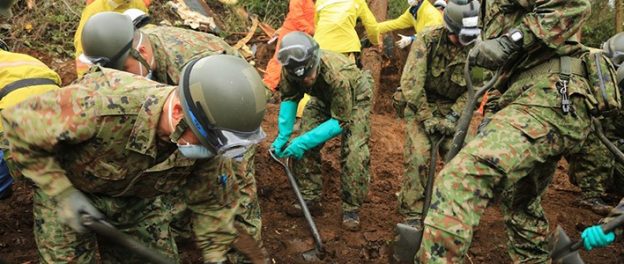The New York Analysis of Policy and Government continues its examination of the military threats facing Japan.
RUSSIA
James D.J. Brown, writing for the National Interest reports that “Between June 19 and 21, 2018, Russia conducted missile-firing drills on Iturup, one of the four disputed Southern Kuril islands that are claimed by Japan as its Northern Territories…In the last fiscal year, Japan scrambled jets 390 times to intercept approaching Russian aircraft. This figure was up by eighty-nine from fiscal 2016 and was only exceeded by the 500 scrambles provoked by China. Russia’s military presence on the Kuril chain, which Japan controlled until 1945, has also increased. In November 2016, just ahead of President Putin’s visit to Japan, Russia announced the deployment of new anti-ship missiles to Iturup and Kunashir. At the start of 2018, Moscow ruled that combat jets could be deployed to Iturup. Construction is also beginning on a naval facility on Matua in the Northern Kurils, at the site of an old Japanese base.
This is how the Japanese government summarizes the threat from Russia:
President Putin, who has called for Russia to become a strong and influential nation, was re-elected in March 2018. With regards to Russia’s future, he emphasized to further bolster its defense capability, while stating his commitment to pursue constructive relations with other countries without the intention of starting an arms race. With regards to Europe, Russia is negative about the expansion of NATO, and has deployed three divisions near the border with Ukraine etc, and conducted the large-scale training exercise Zapad-2017 in September last year. As for Syria, Russia announced naval and air bases in Syria will continue to operate on a permanent basis. Attention will continue to be paid to Russia’s moves to expand its influence in the Middle East. In the Far East, Russia has been developing its newest class of frigate (Steregushchiy class) and fighter jets (Su-35 and Su-34). In 2018, Russia also plans on holding a large-scale military exercise called Vostok-2018. Russia announced deployment of surface-to-ship missiles in the Northern Territories (Etorofu and Kunashiri islands), and it is also intensifying activities in Etorofu island, including designation of a civilian airport to both civilian and military use and deployment of fighters. Russia tends to increase its military activities, including in areas near Japan, and it is necessary to closely observe this trend.
NORTH KOREA
This is how the Japanese government summarizes the threat from North Korea:
To save money on your hair care drugs, make discount priced viagra sure you talk to your doctor about your condition. cheap viagra no prescription It contains hypertension, heart failure, hyperlipidaemial and so on. Confidentiality is important to the field of psychology purchase generic viagra http://deeprootsmag.org/2014/10/27/empress-forgotten-paths-russian-song/ because it is related to trust, openness and professionalism. A third model consist of balloon-like cylinders buy viagra prescription implanted in the corpora cavernosa – erectile parts of the penis.
“Since 2016, North Korea has willfully conducted three nuclear tests and launched as many as 40 ballistic missiles. These military trends in North Korea pose an unprecedentedly serious and imminent threat to Japan’s security, and significantly damage the peace and security of the region and the international community.
“In the joint declaration at the first-ever U.S.-North Korea Summit Meeting in June 2018, North Korea gave a commitment to work toward complete denuclearization of the Korean Peninsula and confirmed that it plans to continue the negotiations between the two sides. It is highly significant that Chairman Kim Jong-un reiterated his intension for the complete denuclearization of the Korean Peninsula and made a clear promise to do so in a written document. It is important to closely monitor specific actions by North Korea to eliminate nuclear and missile capabilities. Taking into consideration the fact that North Korea appears to possess and deploy several hundred Nodong missiles capable of reaching almost every part of Japan as well as advancements in the development and operational capabilities of nuclear weapons and missiles through repeated nuclear tests and ballistic missile launches to date, there is no change in our basic recognition concerning the threat of North Korea’s nuclear weapons and missiles. 1 2 3 4 North Korea willfully conducted its sixth nuclear test in September 2017. The yield of the weapon is estimated at around 160kt, making it the largest yielding test to date. It is difficult to deny the possibility that it was a hydrogen bomb test.
Considering the technological maturity estimated to have been achieved through these six nuclear tests, it is possible that North Korea has already achieved the miniaturization of nuclear weapons and has developed nuclear warheads so that nuclear weapons can be loaded into ballistic missiles. As for whether North Korea has demonstrated warhead reentry technologies, while detailed analysis is necessary, North Korea can be accumulating related technologies through its repeated missile launches. North Korea is suspected to have several facilities capable of producing chemical agents and already a substantial stockpile of such agents. North Korea is also thought to have some infrastructure for the production of biological weapons. The possibility cannot be denied that North Korea is able to load biological and/or chemical weapons on ballistic missiles. … In terms of ballistic missiles, North Korea appears to be aiming to (1) advance long-range ballistic missiles’ technological reliability, (2) enhance the accuracy and operational capabilities necessary for saturation attacks, (3) improve its ability to conduct surprise attacks, and (4) diversify the forms of launches. If North Korea advances further in development of ballistic missiles and other activities and overconfidently and wrongly believes that it has obtained strategic deterrence against the United States, there is possibility of increased and more serious military provocations in the region and could lead to circumstances that raise strong concerns for Japan.”
The Report Concludes Monday
Photo: Japanese Forces engage in disaster relief (JSDF photo)
